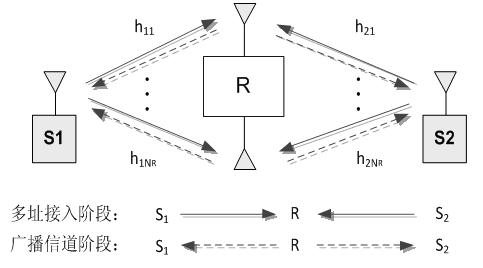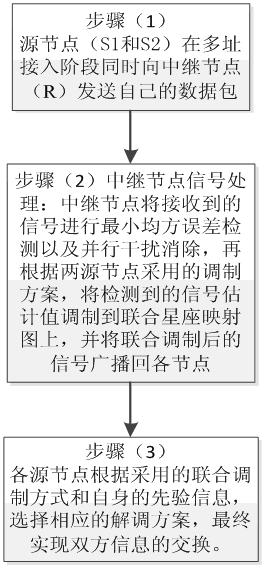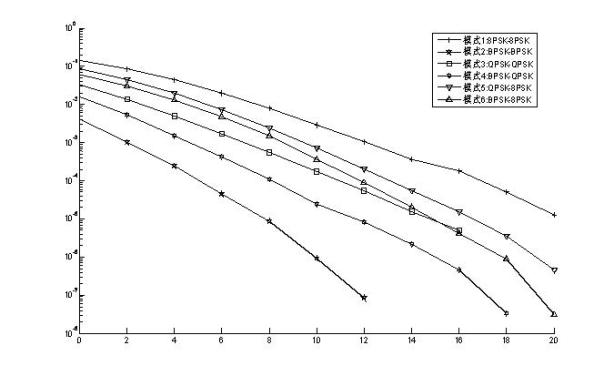Signal detecting method for multi-antenna two-way relay channel
A two-way relay and signal detection technology, applied in the shaping network of the transmitter/receiver, baseband system components, etc., can solve the problems of low throughput, high bit error rate, low computational complexity, etc., and achieve system Effects of Bit Error Rate and Throughput Improvement and Computational Complexity Reduction
- Summary
- Abstract
- Description
- Claims
- Application Information
AI Technical Summary
Problems solved by technology
Method used
Image
Examples
Embodiment 1
[0038] like figure 1 As shown, the signal detection method of the multi-antenna bidirectional relay channel is: in the typical relay system model of physical layer network coding, the bidirectional relay channel system model is the most widely used one. Information exchange takes place with the help of relay nodes. The source nodes S1 and S2 are both equipped with a single antenna, while the relay node R uses multiple antennas to receive signals from the source node.
[0039] like figure 2 As shown in the two-way relay channel system, the flow chart of the relay node processing a request packet is divided into the following steps to achieve:
[0040] a) In a two-way relay system, the source node (S1, S2) sends its own data packets to the relay node (R) at the same time in the multiple access phase, and the relay node R uses multiple antennas to receive the signal from the source node. ;
[0041] b) Relay node signal processing: The joint detection interference cancellatio...
Embodiment 2
[0043] Embodiment two: This embodiment is basically the same as the first embodiment, and the special features are as follows:
[0044]The relay node signal processing is realized from the following two aspects:
[0045] a) Joint detection and interference cancellation algorithm, that is, the algorithm of joint minimum mean square error detection and parallel interference cancellation. This method is implemented in two steps:
[0046] The first step is to pass the received signal through a minimum mean square error detector:
[0047]
[0048] In the formula, Represents the signal matrix of the relay terminal after the minimum mean square error detection, represents the signal value on each receive antenna, Represents the number of receiving antennas at the relay end, is the channel matrix from the source node (S1, S2) to the relay node (R), Represents the matrix of sent signals from source nodes, is the power spectral density of the noise in the channel;
[...
PUM
 Login to View More
Login to View More Abstract
Description
Claims
Application Information
 Login to View More
Login to View More - R&D
- Intellectual Property
- Life Sciences
- Materials
- Tech Scout
- Unparalleled Data Quality
- Higher Quality Content
- 60% Fewer Hallucinations
Browse by: Latest US Patents, China's latest patents, Technical Efficacy Thesaurus, Application Domain, Technology Topic, Popular Technical Reports.
© 2025 PatSnap. All rights reserved.Legal|Privacy policy|Modern Slavery Act Transparency Statement|Sitemap|About US| Contact US: help@patsnap.com



